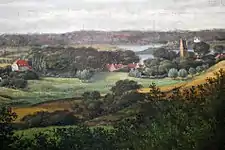Kongens Lyngby
Kongens Lyngby ([ˈkʰʌŋŋ̍s ˈløŋˌpyˀ], Danish for "the King's Heather Town"; short form Lyngby) is the seat and commercial centre of Lyngby-Taarbæk Municipality in the northern suburbs of Copenhagen, Denmark. Lyngby Hovedgade is a busy shopping street and the site of a branch of Magasin du Nord as well as Lyngby Storcenter. The district is also home to several major companies, including COWI A/S, Bang & Olufsen, ICEpower a/s and Microsoft. The Technical University of Denmark relocated to Lyngby from central Copenhagen in the 1970s.
Lyngby station is located on the Hillerød radial of Copenhagen's S-train network.
Kongens Lyngby borders: Brede; the municipality of Gentofte (the most affluent in Denmark); Sorgenfri, where the Danish Prime Minister's official residence, Marienborg, lies; and the Gladsaxe municipality.
History

The name Kongens Lyngby is first recorded in 1348. At that time large parts of North Zealand belonged to the Catholic Church (represented by Roskilde Cathedral and the name Lyngby was associated with several places. Store Lyngby belonged to Arresø church. "Our" Lyngby, on the other hand, was crown land. It may therefore have been to distinguish it from these other places that the name emerged.[1]
The original Lyngby village is now known as Bondebyen. Kongens Lyngby was also the site of a watermill, Lyngby Watermill, which is first mentioned in 1492 but is probably several hundred years older.
A royal road, Lyngby Kongevej, was created in 1584 to provide an easy link between Copenhagen and Frederick's new Frederiksborg Castle from where it was later extended to Fredensborg and Helsingør. It was the first of a number of royal roads created by Frederick II and his successor Christian IV.[2]

In the 18th century, a growing number of country houses were built in the area by civil servants and merchants from Copenhagen. Kongens Lyngby had no market rights but developed into a local service centre with an increasing number of craftsmen and merchants.[3]

The North Line came to Lyngby in 1863 and was extended to Helsingør in 1864,This enabled citizens from Copenhagen to settle permanently in the area. Several factories opened in the area, including Christian Hasselbalck's curtain factory in 1892 which later became the town's largest employer.
In the 1930s, Kongens Lyngby developed into a modern suburb. The North Line was converted into an S-train line with more stations and Kongens Lyngby gradually merged with the neighboring settlements.
Shopping
Kongens Lyngby is the important shopping destination in the northern suburbs. Lyngby Hovedgade is a busy shopping site and is the site of a Magasin du Nord as well as Lyngby Storcenter.
Notable people



- Ida Brun (1792 at Sophienholm – 1857) a Danish singer, dancer, and classical mime artist
- Hans Heinrich Baumgarten (1806-1875) an industrialist of Burmeister & Wain, lived in Lyngby
- Vilhelm Theodor Walther (1819–1892) an architect and Royal Building Inspector for Jutland
- Elisa Marie Thornam (1857-1901) a Danish landscape painter and botanical illustrator
- Vibeke Salicath (1861–1921) a philanthropist, feminist and politician; brought up in Lyngby
- Gyrithe Lemche (1866–1945) a Danish writer, women's rights campaigner and local historian
- Ingrid Jespersen (1867–1938) pedagogue, founded Ingrid Jespersens Gymnasieskole
- Olga Wagner (1873–1963) a Danish painter and sculptor
- Siegfried Wagner (1874–1952) a Danish sculptor, lived in Løveborg in Lyngby from 1900
- Gerda von Bülow (1904–1990) a Danish violinist and music educator, she founded the Institut for Nordisk Rytmik in Lyngby in 1961
- Dagmar Freuchen-Gale (1907–1991) a Danish illustrator, author and editor
- Elsie Albiin (1921 – 2009 in Lyngby) a Swedish actress, lived in Lyngby [4]
- Kasper Heiberg (1928–1984) a Danish painter and sculptor
- Nina Pens Rode (1929–1992) a Danish actress [5]
- Bodil Kaalund (1930–2016) a painter, textile artist and writer; lived in Lyngby from 1943
- Finn Thiesen (born 1941) a Danish–Norwegian linguist, Iranist, translator and academic
- Carsten Koch (born 1945) a Danish economist, politician and minister
- Jette Baagøe (born 1946) runs the Danish Museum of Hunting and Forestry, lives in Lyngby
- Hans Abrahamsen (born 1952) a Danish composer
- Lars von Trier (born 1956) a Danish film director and screenwriter [6]
- Mads Tofte (born 1959) a Danish computer scientist, co-author of Standard ML
- Søs Fenger (born 1961) a Danish vocalist, guitarist, and songwriter
- Eske Willerslev (born 1971) a Danish evolutionary geneticist, lives in Lyngby
Sport
- Henrik Larsen (born 1966) a football manager and former professional player with 368 club caps and 39 for Denmark
- Ib Larsen (born 1945) a Danish rower, team bronze medallist at the 1968 Summer Olympics
- Jacob Bruun Larsen (born 1998), professional footballer
- Frederik Nielsen (born 1983) a professional tennis player
- Jeanette Ottesen (born 1987) a Danish swimmer, participated at the 2004, 2008, 2012 and 2016 Summer Olympics
References
- "Sorgenfri Castle". lyngbyok.dk. Retrieved 21 February 2017.
- "Kongeveje" (in Danish). Gyldendal. Retrieved 21 July 2015.
- "Kommunens historie" (in Danish). Lyngby-Taarbæk Kommune. Retrieved 16 February 2017.
- IMDb Database retrieved 04 August 2020
- IMDb Database retrieved 04 August 2020
- IMDb Database retrieved 04 August 2020
External links
| Wikimedia Commons has media related to Kongens Lyngby. |
| Wikivoyage has a travel guide for Lyngby. |
_21-03-06.jpg.webp)